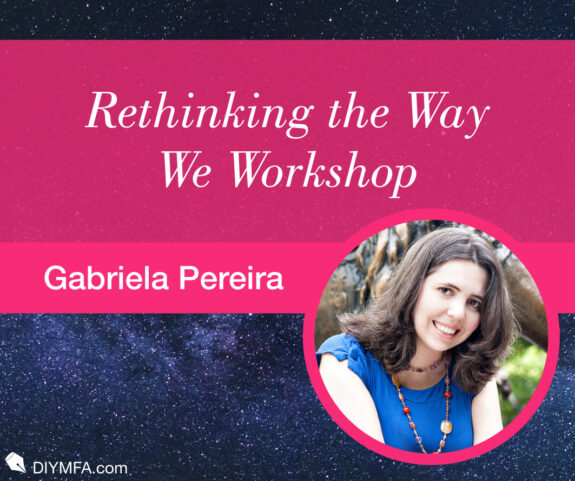Once upon a time, a workshop was considered a place where you did the work. Think of a carpenter’s workshop, with sawdust covering the tables and coils or scraps of wood littering the floors. Or consider Santa’s workshop, where elves engage in the cheery job of making toys for all the good little children of the world. These workshops are messy, lived-in spaces where you will see people—or elves—actually working.
Notice how in the compound word “workshop” the “work” part comes before the “shop.” It’s as though the word itself is telling us to put emphasis on the work first.
Yet, somewhere along the way, workshop went from being a place to being a verb, a thing you did as part of the evaluative process for creative projects. “Let’s workshop these pages and see if we can make them better,” one writer might say to another. Or maybe, “Let’s take these pages to the workshop and see what other people think.”
I suspect this shift might be related to the beginning of one very famous writing workshop which, in the 1930s, established a paradigm for how creative work should be critiqued. The Iowa Writers’ Workshop—and the hundreds of similar programs and courses it inspired—put much more emphasis on the critique aspect than on doing the work itself.
In this model, the act of writing is a private matter, something we should do in the privacy of our wooded cabin or humble garret. Workshop instead becomes a place you would go to talk about writing, rather than actually do it.
What is worse, this workshop model (which has been in place for almost 100 years) is not inclusive to marginalized writers, or even just writers wanting to create something a little bit outside the norm. You see, according to this workshop model, the writer whose work is on deck must sit quietly while the rest of the group offers their impressions of the work. Some workshops even go so far as to put writers in “the box,” “the booth,” or “the cone of silence.” The reasoning behind this method is supposedly to avoid defensiveness and lend some objectivity to the process. Yet all it does is create a one-sided discussion that excludes the writer whose work it is. This approach can be problematic or even harmful.
I remember, back when I was an itty-bitty baby writer, taking a workshop where we adhered strictly to the box method. It was an introductory fiction workshop with writers of all genres/categories, and at the time, I was working on some middle grade short stories. When it came my turn for critique, the class squandered my entire thirty minutes talking about how the voice of my story was juvenile. Well, no kidding it was juvenile—I was writing for 10-year-old readers. I wasn’t about to sound like Faulkner. If the workshop had allowed for dialogue, if I had been permitted to break out of the booth and tell my classmates what my intended audience was, we probably would have skipped past “juvenile” and actually gotten to a productive discussion. Silencing the writer turns the workshop into nothing more than a talkshop.
I hate to admit it, but until around a year ago, I still operated according to this same problematic paradigm. The truth is, I didn’t realize it could be any other way. This was how I had been taught in every writing class I ever took, including at the traditional MFA I attended. I’m embarrassed to say that even DIY MFA used the “Loving Bubble of Support” method of critique for quite some time. Sure, it might sound more warm and fuzzy than a cone of silence, but it still hearkens to that same tradition of silencing the writer who has the most at stake in the discussion.
Now we do things differently and (in my opinion) so much better. First and foremost, we acknowledge that critique is not a one-sided discussion, but rather a dialogue, and the writer whose work is being workshopped should be the one leading the charge.
Critiquing someone else’s work when they can’t talk back is easy. Holding a true dialogue and approaching that work with curiosity and compassion is hard work. Hence, the term “workshop.”
In her fabulous book The Antiracist Writing Workshop: How to Decolonize the Creative Classroom, Felicia Rose Chavez talks about many different ways to bring work back into the workshop setting. Having students write longhand journal entries in response to thought questions in class. Creating an environment that engages the senses and gets writers out of their seats. Building a collaborative lexicon, both in terms of common craft vocabulary and also a classroom-inspired collection of reading material.
All these are ways to put the “work” back in workshop. After all, as Chavez says: “Workshop isn’t workshop if someone doesn’t accidentally trip over a writer.”
At DIY MFA, we also believe that workshops should be about doing the work, about putting words on the page. This is why, as I’ve developed new curriculum over the past year, I have made a deliberate effort to incorporate hands-on activities, like freewriting and roleplay. The goal, of course, has been to nudge writers outside their comfort zones and get them actually writing, rather than simply talking about the work. My hope is that writers who participated in our programs this past year have reaped the benefits of a true workshop.
Until next time, keep writing and keep being awesome!

P.S. For more info on Gabriela Pereira, the founder and instigator of DIY MFA, check out her profile page.







